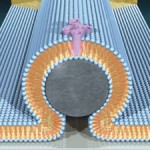Machines Becoming Minute Cell Matter
Posted on June 10, 2010
Filed Under Technology | Leave a Comment
Practical uses are still years away, but we’re pleased to note that researchers have found a way to link technology with human cells very closely.
A nano-sized transistor is embedded in a cell-like membrane – “the most intimate binding of man and machine yet achieved.”
 “This device is as close to the seamless marriage of biological and electronic structures as anything else that people did before,” says Aleksandr Noy, a scientist at the University of California. The device is an implanted circuit, beginning with a simple transistor. But instead of using silicon, the most common material in transistors, the researchers “used a next generation material known as a carbon nanotube, a tiny straw-shaped material made from a single curved layer of carbon atoms arranged like the panels of a soccer ball.
“This device is as close to the seamless marriage of biological and electronic structures as anything else that people did before,” says Aleksandr Noy, a scientist at the University of California. The device is an implanted circuit, beginning with a simple transistor. But instead of using silicon, the most common material in transistors, the researchers “used a next generation material known as a carbon nanotube, a tiny straw-shaped material made from a single curved layer of carbon atoms arranged like the panels of a soccer ball.
“The scientists then coated the carbon nanotube transistor with a lipid bilayer, basically a double wall of oil molecules that cells use to separate their insides from their environment.” They did’t use an actual cell membrane, however…
There’s more on the technique in the online article in Discovery News. The bottom line is it may one day be possible to gather information “about the inner workings of disease-related proteins inside the cell membrane, and eventually lead to new ways to read, and even influence, brain or nerve cells.”
This kind of research holds promise for people with bodily ailments, though “any actual treatment is still years away.” Wouldn’t it be great if something like this could be used to restart, say, damaged spinal cells and restore motion in inert muscles?
Whatever eventually results from work like this, the point is that technical ingenuity is being combined in the most intimate way imanginable with building-block bodily structures. Mind and matter are on their way, in given applications at least, to becoming one. – Doug Bedell
– The illustration is an artist’s representation of a new transistor that’s contained within a cell-like membrane. In the core of the device is a silicon nanowire (grey), covered with a lipid bilayer (blue).
Comments
Leave a Comment
If you would like to make a comment, please fill out the form below.
Recently
- Presentations With Forethought
- Technical Writing’s Lineage – Surely It’s Deeper than Digital
- At the Holidays, Twitting Amazon
- Successful Cookie Baking – From Mom, an Acknowledged Expert
- Slides for a Tech Writer’s Craft
- Digital or Not, Be Clear
- Being Watchful About Digital Designs…
- When Proposals Don’t Click, Keep Making Them Anyway
- Like a Good Gardener, Help an Enterprise Keep Itself Current
- We’re Leaders All, And Need to Think That Way
Categories
Archives
- January 2017
- December 2016
- November 2016
- October 2016
- September 2016
- August 2016
- July 2016
- June 2016
- May 2016
- April 2016
- March 2016
- February 2016
- January 2016
- December 2015
- November 2015
- October 2015
- September 2015
- August 2015
- July 2015
- June 2015
- May 2015
- April 2015
- March 2015
- February 2015
- January 2015
- December 2014
- November 2014
- October 2014
- March 2014
- February 2014
- January 2014
- December 2013
- November 2013
- October 2013
- September 2013
- August 2013
- July 2013
- June 2013
- May 2013
- April 2013
- March 2013
- February 2013
- January 2013
- December 2012
- November 2012
- October 2012
- September 2012
- August 2012
- July 2012
- June 2012
- May 2012
- April 2012
- March 2012
- February 2012
- January 2012
- December 2011
- November 2011
- October 2011
- September 2011
- August 2011
- July 2011
- June 2011
- May 2011
- April 2011
- March 2011
- February 2011
- January 2011
- December 2010
- November 2010
- October 2010
- September 2010
- August 2010
- July 2010
- June 2010
- May 2010
- April 2010
- March 2010
- February 2010
- January 2010
Blogroll